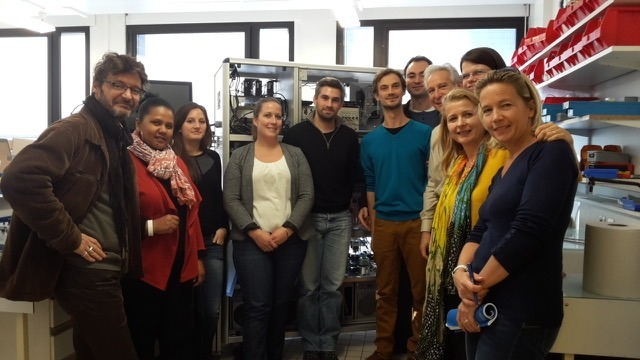CCHS is a disease characterized by a congenital impairment of the central control of breathing, associated with dysfunctions of the autonomic nervous system (ANS) (Gallego, 2012). At birth, patients have severe and persistent hypoventilation during sleep and a strongly reduced ventilatory response to CO2 and hypoxia. All patients require assisted ventilation during sleep, or permanently in the most severe cases. The NeoPhen team has been working for several years to better understand this disease, improve patient care and make progress in the search for a pharmacological treatment.

© NeuroDiderot
Context
CCHS is a disease characterized by a congenital impairment of the central control of breathing, associated with dysfunctions of the autonomic nervous system (ANS) (Gallego, 2012). At birth, patients have severe and persistent hypoventilation during sleep and a strongly reduced ventilatory response to CO2 and hypoxia. All patients require assisted ventilation during sleep, or permanently in the most severe cases. Some patients presenting milder respiratory disorders (late-onset CHS) are diagnosed at later ages, even adulthood, upon the occurrence of respiratory-related episodes such as sedation, anesthesia, or sleep apnea management (Patwari et al., 2010). The disease can be isolated or associated with a spectrum of non-respiratory symptoms, among which seizures and other conditions that reflect a more global ANS dysfunction, including cardiac arrhythmias and congenital heart disease, ocular disorders, Hirschsprung’s disease and neural crest tumors (Di Lascio et al., 2020). The incidence of CCHS is estimated to be between 1 in 50,000 and 1 in 200,000 births (Bardanzellu et al., 2019).
Most cases of CCHS are sporadic and result from a de novo heterozygous mutation in the PHOX2B gene, which encodes a transcription factor critical for the development of the autonomous nervous system. Heterozygous mutations of PHOX2B are most frequently found at the level of exon 3 of the gene. The predominant mutation (in 90% of patients) is an expansion of polyalanine (from +4 to +13, Polyalanine repeat mutations, PARM) within a series that normally contains 20 alanine, the most commons being +5 and +7 (Weese-Mayer et al., 2010). The size of the expansion correlates with the severity of the respiratory disorder and the number of associated symptoms (Matera et al., 2004; Weese- Mayer et al., 2010). Other mutations, such as missense, nonsense, or frameshift, within the PHOX2B gene (non-polyalanine mutations, NPARM, 10% of patients) are frequently associated with presence of tumors or Hirschsprung’s disease. Inheritance is autosomal dominant.
Methods
At the preclinical level, we are studying mice with genetic mutations identical to those identified in patients. They present a respiratory deficit of the same nature as that of the patients and therefore die a few hours or days after birth if we do not intervene. We have recently shown that they have an abnormally high number of so-called obstructive apnoeas at birth, due to associated upper airway closure, and abnormalities in the functioning of the centre in the brain responsible for controlling the muscles of the upper airway. These animals therefore have both an abnormality of respiratory control and abnormalities of upper airway tone.
At the clinical level, our hospital team is a Centre de Référence Maladie Rare (CRMR) for central alveolar hypoventilations and therefore welcomes all French children suffering from Ondine syndrome. In order to investigate these pathologies, we have developed the non-invasive study of ventilatory control (loop gain model) and are the only European centre to carry out this type of exploration.
Main results
Since the discovery of the gene responsible for Ondine syndrome, the PHOX2B gene, research conducted by the international community, in particular by the SleepCmd team at NeuroDiderot, has led to significant progress in the understanding of the pathophysiology of Ondine syndrome. These results allow us to improve the management of patients and pave the way for the development of treatments. Our work in the SleepCmd team has led to the publication of several important results:
- Heart rate variability in congenital central hypoventilation syndrome: relationships with hypertension and sinus pauses. Pediatr Res. 2023
- Obstructive apneas in a mouse model of congenital central hypoventilation syndrome., Am J Respir Crit Care Med. 2021.
- Breathing under Anesthesia: A Key Role for the Retrotrapezoid Nucleus Revealed by Conditional Phox2b Mutant Mice., Anesthesiology 2019.
- Effects of temperature on ventilatory response to hypercapnia in newborn mice heterozygous for transcription factor Phox2b. Am J Physiol Regul Integr Comp Physiol. 2007
-
Sleep-disordered breathing in newborn mice heterozygous for the transcription factor Phox2b. Am J Respir Crit Care Med. 2005
Collaborations
Research on Ondine syndrome could not exist without a wide network of collaborations. We have long-standing collaborations with: Prof. Jeanne Amiel, Dr. Muriel Thoby-Brisson, Prof. Laurence Bodineau, Dr. Florence Cayetanot, Prof. Thomas Similowski, Prof. Christian Strauss, Prof. Andrée Delahaye-Duriez, Dr. Isabella Ceccherini. Work on CCHS is also coordinated at the national level in the Filière de Santé Maladie Rare Respifil.
Funding
Researches on CCHS are possible thanks to the financial support of: Association Française du Syndrome d’Ondine, Fonds de Recherche en Santé Respiratoire, Fondation du Souffle, Société Française de Recherche et Médecine du Sommeil, Fondation Air Liquide, Région Ile-de-France, Legs Poix, Fondation Maladies Rares, & the CCHS Fundation in the US.
Read more

Sleep2Develop research program
The Sleep2Develop program investigates the role of sleep as a promotor of neurodevelopment and identifies the sleep determinants of childhood development. This is rephrased as Sleep(to)Develop? or Sleep(to)Develop! Our sleep research combines clinical and...

Breaking news for Central Congenital Hypoventilation Syndrome
In collaboration with Dr. Muriel Thoby-Brisson (Université de Bordeaux, Institut de Neurosciences Cognitives et Intégratives d’Aquitaine, CNRS), and thanks to Fondation Air Liquide, Association Française du syndrome d'Ondine and start-up company ATMOSR, team NeoPhen...

Bad Dreams and Nightmares Preceding Suicidal Behaviors

Project – CCHS Foundation 2021
Team SleepCmd, in collaboration with team NeuroDev (Dr. Andrée Delahaye), receive support from the CCHS Foundation in 2022 to study the genetic dysregulations that could be associated with Congenital Central Hypoventilation Syndrome (CCHS). Members of the SleepCmd and...
